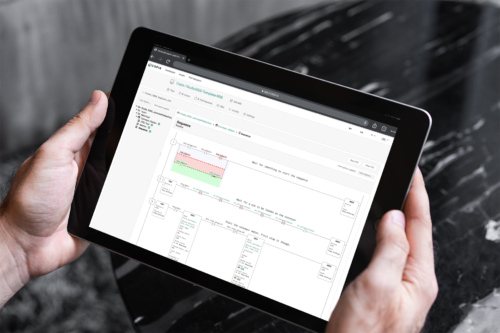Optimize your process; manage your assets
Whether managing changes to automation systems or responding to control loop behaviors, one thing is certain: As automation systems increase in complexity, performance expectations also increase. And as performance expectations become more demanding, maintaining these automation assets has never been more critical.
Whether managing changes to automation systems or responding to control loop behaviors, one thing is certain: As automation systems increase in complexity, performance expectations also increase. And as performance expectations become more demanding, maintaining these automation assets has never been more critical.
Software suites can help engineers assess problems. However, process knowledge and engineering skill are necessary in properly applying these tools to any optimization effort.
The two interviews that follow discuss ways engineers in the process industries can help their companies optimize their automation assets — one through managing automation configuration; the other through ensuring control loop stability.
Optimizing assets with configuration management
Based in Houston, PAS is a global provider of operations and automation effectiveness solutions to the process and power industries, and is known for its alarm management and DCS configuration management solutions as well as the development of a multi-vendor automation genome mapping system.
Eddie Habibi is founder and CEO of PAS, and coauthor of the book “Alarm Management Handbook: A Comprehensive Guide.” AppliedAutomation talked with Habibi about the criticality of automation system configuration management and its importance to plant lifecycle management and automation system modernization.
AA: Configuration problems can crop up in any automation system at any time. When and where do process plants experience the most configuration problems?
Habibi : Automation system configuration management is critical to plant lifecycle management as well as during modernization of such systems. As the platform for implementing operational improvement strategies, plant automation systems are in a constant state of change. Issues in plant operation can arise at anytime if such changes are not properly managed. Improper configuration changes to the automation system can result in undesirable consequences that can range from minor product quality deviations to complete unintended plant shutdowns.
AA: What are the most common configuration problems that process plants experience?
Habibi : Automation system configuration problems occur predominantly as a result of changes made to the system that are not properly managed. Changes that can potentially impact the operation of a unit include modifications to the alarm settings, operator displays, programs and the like.
AA: What causes these configuration problems?
Habibi : Configuration problems are primarily human induced: plant operators, engineers and others who can access and modify the system configuration. Other threats to the automation systems include external cyber and incidental virus attacks. Natural disasters such as hurricanes and tornadoes also put automation system configurations at risk, as was evident during Hurricanes Katrina and Rita.
In order to mitigate these problems, an automation disaster recovery strategy is needed. In fact, a configuration management system may provide the platform for disaster recovery as it contains all the programs, databases and applications to restore a system after a disaster.
AA: How do the existence and operation of multiple control systems (DCS, PLC, single- or multiple-loop controllers, etc.) AND their potential interactions affect automation system configuration? Operation?
Habibi : An automation infrastructure at a modern plant may include a variety of systems from a multitude of vendors. These disparate systems collectively create an integrated meta-system that must work harmoniously in order to deliver its intended purpose.
As the number of sensors, control systems and applications at a plant increase, the complexity and the need for improved methods for maintaining such systems increase. This added complexity exponentially increases the challenge of properly managing these systems. In fact, without a proper automation configuration management system, effectively maintaining an automation meta-system becomes untenable.
AA: What are the best ways to resolve these configuration problems?
Habibi : Preventing automation configuration problems from occurring to start with is the best means for addressing these problems. But given that automation systems are the platform for the embodiment of a plant’s continuous process improvement strategies, it is accepted that plant personnel will be making changes to these systems.
What is needed is an automated system for continuous monitoring and reporting of the performance of automation systems. A rigorous automation configuration management system must at least offer the following capabilities:
-
Automatic collection and archiving of configuration databases
-
Identification of references and relationships among data points, applications and systems
-
Automated near-real time documentation
-
Simple visualization of complex relationships and strategies
-
Automated change tracking
-
Automated code integrity checking (error detection).
-
AA: What is the single biggest factor a plant manager and/or control engineer should consider when looking at configuration management of their overall automation systems?
Habibi : Without proper configuration management, a plant is at high risk in the same way as it would be if it did not have an effective management of change process for its safety relief valves. A plant should not operate without an effective automation configuration management system that includes the requirements and capabilities listed above.
Optimizing control loop performance
GreenLine Controls, also based in Houston, helps companies in the process industries improve production by solving process control problems, optimizing the performance of process control systems and training personnel in the field of process control. Jacques Smuts, Ph.D. is the founder and president of GreenLine Controls, and was previously the vice president of technology at PAS. Prior to PAS, Smuts was was president and cofounder of ControlServe Ltd. AppliedAutomation talked with Smuts about identifying, diagnosing, correcting and preventing control loop problems.
AA: In the average process plant, what is the percentage of control loops that actually operate properly at any given time? Percentage of improperly operating loops?
Smuts : Two papers dating back to 1993, authored individually by Ender and Bialkowski (respectively), claimed that roughly 30% of loops were left in manual, 30% actually increased variability, 20% performed fairly and that only 20% of loops performed well. In 2001, Desborough and Miller confirmed control loop performance was on average still the same. In 2008, VanDoren also reported a very similar bleak state of loop performance.
Our experience from loop performance audits supports these findings, although the distribution between loops in manual, those with poor performance and those with good performance can vary significantly between different sites and process types.
AA: Please define what “operating properly” really means.
Smuts : Proper operation can be subjective, and it is easier to define improper operation. Loops increasing variability when running in auto, compared to manual control, would not be considered as operating properly. Nor would controllers reacting mainly to noise and high-frequency disturbances, or those causing oscillations in the loop. Controllers with outputs running into limits, and controllers tuned too sluggishly are also not operating properly. So, for a loop to be “operating properly,” it needs to reduce variability, and do so in a repeatable fashion, consistent with its function in the larger process.
AA: What are the causes of improperly operating control loops?
Smuts : Improper operation can be caused by incorrect controller tuning settings, incorrect process variable filter settings; faulty or incorrectly positioned instrumentation; or mechanically defective, non-linear, oversized or undersized final control elements. It can also be caused by not making use of an appropriate control strategy (like feedforward or gain scheduling), or improper design of such a control strategy (like dividing one flow by another for doing ratio control).
AA: What are the consequences of control loops that are not operating properly?
Smuts : A poorly performing control loop can decrease product quality, limit maximum production rates, extend process start-up and transition times, increase the likelihood of unplanned process shut-downs, increase maintenance costs, consume more energy and make the process difficult to operate.
AA: How are these control loop issues resolved?
Smuts : The first step is to find the problem loops. Some problematic control loops are obvious due to their impacts on operations, while others might be less obvious or remain hidden to operators and process engineers. A comprehensive list of control problems can be obtained most effectively by using software to assess the performance of all control loops.
The second step is to distill the performance survey down to a list of bad actors by looking both at the performance and the relative importance of each control loop. Bad actors would be loops performing poorly and also significantly impacting the process. Loop assessment software can do this automatically if they are configured properly.
The third step is to diagnose the root cause of the problems. Loop assessment software is helpful in doing this, but engineering and process knowledge is also required. The final step is fixing the problem according to the diagnosis, for example, by tuning a controller, fixing a control valve or implementing the appropriate control strategy.
Pesky control problems exist mostly because the root causes of the problems are not being addressed. For example, an engineer may spend hours tuning and re-tuning a control loop, but his efforts are futile if the problem actually is a sticky control valve requiring maintenance, or a nonlinear process requiring gain scheduling.
AA: What is the single biggest factor a plant manager and/or control engineer should consider when looking at optimizing their control loops?
Smuts : The single biggest factor is the skill level of the person doing the optimization work. Software has come a long way to simplify loop performance analysis and tuning, but the software is just a tool, and the validation of its diagnoses and execution of corrective actions need to be done by an adequately skilled human.
Eddie Habibi, founder and CEO, PAS
Jacques Smuts, Ph.D., founder and president, GreenLine Controls
Do you have experience and expertise with the topics mentioned in this content? You should consider contributing to our CFE Media editorial team and getting the recognition you and your company deserve. Click here to start this process.





